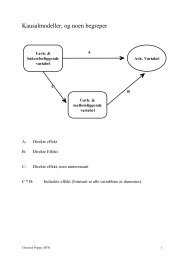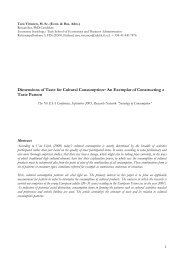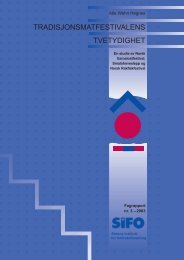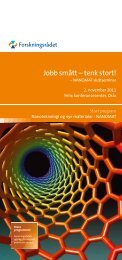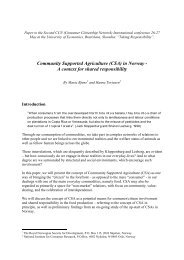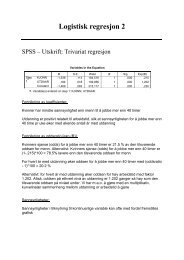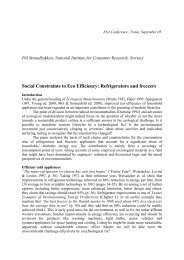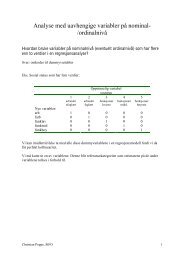an investigation of domestic laundry in europe - habits ... - SIFO
an investigation of domestic laundry in europe - habits ... - SIFO
an investigation of domestic laundry in europe - habits ... - SIFO
You also want an ePaper? Increase the reach of your titles
YUMPU automatically turns print PDFs into web optimized ePapers that Google loves.
Assessment <strong>of</strong> the consumer <strong>laundry</strong> <strong>habits</strong> - a qu<strong>an</strong>titative survey 37As a general rule underp<strong>an</strong>ts are washed at the warmest temperatures. For amajority <strong>of</strong> the respondents <strong>in</strong> the countries other th<strong>an</strong> Spa<strong>in</strong> it seems that 60°C is the most common temperature for launder<strong>in</strong>g underp<strong>an</strong>ts. The Greekrespondents are most <strong>in</strong>cl<strong>in</strong>ed to boil their underp<strong>an</strong>ts, followed by the Norwegi<strong>an</strong>s.On the whole, underp<strong>an</strong>ts are the garments that are ch<strong>an</strong>ged most<strong>of</strong>ten <strong>an</strong>d washed at the highest temperature.2.5 Products used for do<strong>in</strong>g <strong>laundry</strong> <strong>in</strong> the householdOur next question is what k<strong>in</strong>d <strong>of</strong> products the respondents use when do<strong>in</strong>gtheir <strong>laundry</strong>. In the questionnaire, n<strong>in</strong>e different products were listed. Five <strong>of</strong>these are used directly when wash<strong>in</strong>g clothes (wash<strong>in</strong>g powder, wash<strong>in</strong>g tablets,wash<strong>in</strong>g liquids, detergents for wool <strong>an</strong>d silk <strong>an</strong>d detergents for colouredclothes), while four are not so directly connected to the wash<strong>in</strong>g process, butare still relev<strong>an</strong>t. These are: sta<strong>in</strong> remover, chlor<strong>in</strong>e treatment or other bleach<strong>in</strong>gagents, fabric conditioner, <strong>an</strong>d a measur<strong>in</strong>g cup for the dosage <strong>of</strong> detergents.In the follow<strong>in</strong>g we shall have at look at the distribution <strong>of</strong> these products.2.5.1 DetergentsIt is among the Sp<strong>an</strong>ish respondents we f<strong>in</strong>d the greatest number <strong>of</strong> <strong>laundry</strong>products (on average 5.9) <strong>an</strong>d among the respondents from the Netherl<strong>an</strong>dswe f<strong>in</strong>d the least. Our first task was to exam<strong>in</strong>e whether there are <strong>an</strong>y differencesbetween the countries when it comes to the use <strong>of</strong> detergents. Figure 2-16 presents these results graphically.Table 2-3 Number <strong>of</strong> <strong>laundry</strong> products <strong>in</strong> the household <strong>in</strong> different countries. Me<strong>an</strong>.(N=3896)CountryNetherl<strong>an</strong>dsGreeceNorwaySpa<strong>in</strong>Me<strong>an</strong>5.25.55.65.9The respondents <strong>in</strong> all <strong>of</strong> the countries report that wash<strong>in</strong>g powder is the mostcommon detergent (see figure 2-16). In Greece 96 % <strong>of</strong> the respondents usethis product. Among the Sp<strong>an</strong>ish respondents it is somewhat less common –only 86 % use wash<strong>in</strong>g powder.




